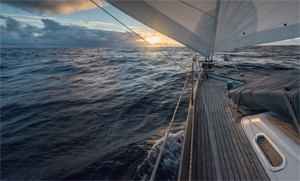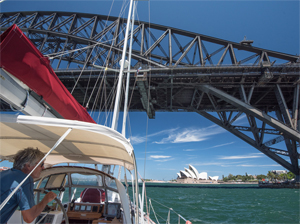Bob and Sue Dall set out to circle the globe in three years, and years later they are still happily making their way around the world. Bob, a petroleum engineer, retired from the oil industry in 2008. He had for many years been a keen glider pilot. While living in Scotland he learned to sail small dinghies, and from there several family holidays were spent on flotillas in the Caribbean and Mediterranean. After retiring, he achieved his Yachtmaster certificate and then set about finding a bluewater cruising yacht.
Sue was a graphic artist when she met Bob in the late 1970s. She shared Bob’s passion for gliding, but sailing — especially around the world — had never been on her bucket list!
Bob was determined to find the right boat for the job. Eighteen months before they set off, they bought Mawari, a 3-year-old, 40-foot Najad 400 monohull. Bob spent all his spare time getting to know her inside and out, an essential for circumnavigation.
 |
|
Bob on the deck of Mawari, their Najad 400, while new decks are installed in Phuket, Thailand. |
|
Sue Dall |
Although they thought she was very well equipped when they bought her, they have subsequently changed and added a lot of equipment. The most notable additions were a substantial rear arch that supports the solar panels and wind vane among other things, a second furler for a jib and a two-pole system for downwind sailing.
They set off from the U.K. in July 2010 on their planned three-year circumnavigation; more than eight years later, they are a little past halfway complete. They crossed the Atlantic from the Canaries to Antigua in November and December that year. Mawari is currently in Malaysia, having sailed via the East Coast of the U.S., Cuba, Panama, the Galapagos, French Polynesia, the Cook Islands, Samoa, Tonga, New Zealand, Fiji, New Zealand, Vanuatu, Australia and Indonesia. Apart from the Atlantic crossing when they were joined by their son, Bob and Sue sailed with just the two of them on board.
The Dalls have three children based in the U.K., and have visited the U.K. every year since they set off.
 |
|
At anchor at Bay of Islands, New Zealand. |
|
Sue Dall |
OV: What is your philosophy regarding voyaging gear? Do you like a systems-rich approach, or do you prefer to keep gear simple?
BD: We think that it is extremely important that all systems are as simple and understandable as possible. Our principal navigation setup is based around a Raymarine chartplotter that I guess you could consider part of a system, as it connects to the wind instrument, log, AIS, VHF and Raymarine Autohelm. Everything else operates independently.
OV: What tools do you have on board? Are there any tools you consider vital?
BD: I aim to have tools to tackle any job on the boat with the possible exception of some parts of the engine or gearbox. A very large adjustable spanner is vital for seacocks and associated pipework. A portable vise helps a lot when you need to cut or drill. A power drill is essential, along with good quality sockets, including long ones, spanners, Allen keys and torque drivers. Most things on the boat are metric, but there are a few things with imperial sizes and it’s important to have tools to fit.
OV: How do you decide what spares to carry? Has your mix of spares changed as you’ve voyaged?
BD: It’s difficult to be precise; it’s a judgment based on cost, likelihood of failure and availability of alternate equipment. Naturally, it changes with experience. In a number of places, I have replaced equipment as a precaution and kept the old working item as a spare — a good example is our Mamba drive for the Autohelm autopilot.
 |
|
Mawari under power while on a passage from Thailand to Malaysia. |
|
Sue Dall |
OV: Do you think it is getting easier or more difficult to find skilled boatyard workers around the world?
BD: I can’t say, as we have not stayed in one place long enough to form an opinion. However, I would say that it pays to be very cautious wherever you are. In richer countries, you pay more for bad work than you do in poor ones. Our worst experience was in an expensive and prestigious yard in the U.S. Our second-worst experience was in Australia. Our best experiences were in Thailand and New Zealand.
OV: What kinds of repair work do you attempt yourself?
BD: Anything I can, or if I can’t then I remove the offending item and get it fixed or replaced and refit it. What I can’t do is things like swaging standing rigging, repairing a corroded heat exchanger or fitting a new teak deck.
OV: Do you use wind vane steering or do you rely on an electric autopilot?
 |
|
Downwind sailing with twin headsails off Australia. |
|
Sue Dall |
B&SD: We have a Raymarine Autohelm and a Hydrovane. The Hydrovane is there as a backup in case the electronic system fails or indeed the electrics on the boat fail. As we are two-handed, we cannot seriously contemplate hand-steering for any length of time. The electronic system is so easy to use and does not use a lot of power if the boat is properly balanced as it must be to use the Hydrovane. The Hydrovane has the additional advantage of providing an auxiliary rudder in case of damage to the main rudder.
OV: Is your boat equipped with a watermaker? What are the reasons for having one/not having one?
B&SD: We have a small DC-powered watermaker that makes 12 liters per hour at about 8 amps (12V). It is made by Katadyn. It is very simple and has been very reliable, unlike a lot of the larger, more sophisticated systems. A watermaker makes long passages far more comfortable, allowing us to shower daily without worrying about running out of water. It is vital in countries where clean water is hard to come by, which are usually the places you most want to visit and spend time. If I were starting again, I would look into getting an engine-driven system, as they are capable of delivering large volumes without the need for a generator. I know cruisers who put any water they can get in their tanks and carry bottled water for drinking and cooking. I hope that the recent publicity regarding the devastation caused by plastic bottles puts an end to this behavior.
OV: Do you rely on paper charts or electronic charts, or do you use both?
 |
|
Mawari’s stainless-steel arch designed and fitted in New Zealand in 2015. |
|
Sue Dall |
BD: We principally rely on electronic charts. To start with, we tried to have paper charts sufficient to navigate, but it quickly became apparent that this involved a massive volume of paper and a huge expense (even with unofficial copying). After having obtained all these charts, they then stay rolled up.
In addition to our Raymarine chartplotter, we have OpenCPN on our boat computer, which has access to GPS from a number of sources, plus at least two iPads with built-in GPS and Navionics charts. I am aware that we are vulnerable to GPS being shut down, but that seems a small risk, plus our mobile phones claim to have access to the Russian system (GLONASS). We don’t have a sextant.
We make a lot of use of Google Earth images in areas with poor charting. This is only possible with electronic navigation.
We always have large-scale charts for planning.
OV: To what extent do you use smartphones or tablets on board?
 |
|
Heading under Sydney Harbour Bridge. |
|
Sue Dall |
BD: When we first set out, we were always looking for Wi-Fi and had boosters to pick up distant signals from bars, etc. As time has gone on, mobile phone Internet has got better and better, and in places like Australia you can use it while coastal cruising to pick up rain radar from local met stations to help dodge thunderstorms. As phone signals get better, smartphones and tablets become more and more useful. We are planning to purchase an Iridium GO for our crossing of the Indian Ocean, and that allows satellite calls to be made from a smartphone.
OV: What system do you plan to add or remove in the coming year?
BD: Last year, our generator failed due to corrosion caused by a series of seawater leaks. We do not plan to replace it for a number of reasons. Instead, we will fit a large alternator and a Watt & Sea water-powered generator. This should provide more flexible and reliable charging at anchor and on passage at a lower cost than a new generator.
We have four 105-watt solar panels and a wind generator, as well as battery chargers that require shore power or a generator.

